Mike Schachtrup wears many hats. On any given day, he might assume the role of biologist, economist, heavy equipment operator, systems engineer or technologist, among others. It’s all part of being a farmer—what once might have seemed like a straightforward occupation is today nothing of the sort.
With more than four decades in the fields of central Illinois, Schachtrup has seen it all. A third-generation farmer, he and his brother Steve care for 6,000 acres of “prime black dirt” in Peoria, Tazewell, Knox and Warren counties, in addition to operating a grain elevator in Brimfield. During the growing season, they’ll be up before daylight and won’t make it home until after dark.
Their great-grandfather Frank Schachtrup came to the U.S from Germany in 1866. Frank’s youngest son, Herman, quit school after the third grade to labor on the family farm in Iowa before going to work in the Rock Island Armory as a teenager. During this time, he was briefly one of John L. Sullivan’s sparring partners—the heavyweight boxing champion of the world. After contracting tuberculosis, Herman left the Armory and came to Peoria, where he purchased the Peoria Barber College and took up the barber trade.
After a series of land acquisitions, Herman’s son Francis became a farmer in the 1940s, shortly after the Great Depression. Mike joined his father in the field in the early ’70s, followed by Steve several years later. In the years since, they’ve been through feast and famine, working to keep operations lean and efficient while experiencing all the ups and downs of a cyclical economy—and staying on top of the latest ag technologies.
How did your family acquire their first farmland?
When my grandfather, Herman, married my grandmother, her three sisters moved in, too. They all pooled their money and bought the first farm in 1932 or ’33, for $90 an acre. They started with 160 acres and then a few years later bought another 100 acres in Morton. He later traded that out for a different parcel in Tazewell County.
When my dad graduated from high school, he bought a parcel at Spring Lake. At the time, the older generation was just getting cleaned up from the Depression, so everybody was afraid to invest in anything. He bought the first parcel down there and never thought a thing of it. Timing is everything.
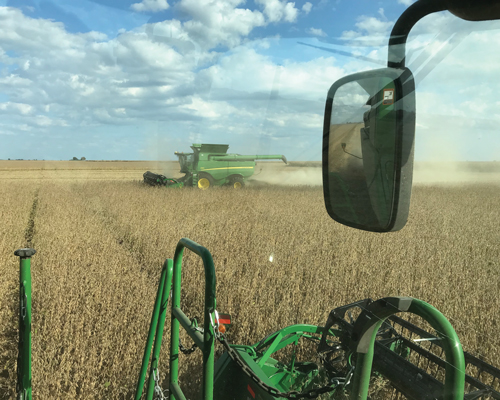 Then in 1959, my dad burned out. My mom said he worked seven years without a day off—because he had so much livestock. So my grandfather encouraged him to get rid of them all: anything that walked. It was a good time to sell, because he had enough money to put a down payment on 400 acres of prime black dirt in Brimfield.
Then in 1959, my dad burned out. My mom said he worked seven years without a day off—because he had so much livestock. So my grandfather encouraged him to get rid of them all: anything that walked. It was a good time to sell, because he had enough money to put a down payment on 400 acres of prime black dirt in Brimfield.
How did he get into livestock?
In the ‘40s, that was just the way things worked. You had corn and oats and some wheat. Soybeans were new. You had hay ground and pasture, a lot of fences. You rotated your land. Not a lot of commercial nitrogen yet. As the machinery got bigger, you started to see the livestock go, and you started to see the fences go.
When did you know you wanted to be a farmer?
From the time I was about seven or eight years old. I was out there all the time—I’d help dad with livestock chores.
What was it like working with your dad?
He was a taskmaster! [Laughs] He showed up about 9:00 and expected all the equipment to be lubricated and ready to go. My brother and I made sure of that. Of course we were there a little after daylight.
We had a hell of a work ethic. When you grow up that way, you don't know any different. You're only going to get one chance to do everything you do. If nature throws you a curve, that's part of the game—you deal with it. But you can't deal with imperfection. Everything has to be as perfect as you can possibly do it—on everything you do, from the planting, to the applications of herbicide to fertilizer. Everything.
How did you plant back then—before all of today’s modern technologies?
Well, you had a planter; there were no monitors. They had cans where you put the seed in, and they had a flat plate and a stick that stood up with a marker on it. So as the seed went out, you'd see the bobber go down. If you had a problem, you might not notice it for 10 or 15 acres.
We worked the ground to death, because you didn't have a lot of ability to use herbicides. Your main herbicide was steel… tearing the weeds up and getting it as flat and perfect as could be, because you knew you had to come back and row-cultivate it twice, which was terribly painstaking.
We plant now and don't do anything but strip-tilling in the fall, and fertilizer, herbicide, insecticide and fungicide applications, if and when needed. In those days, after you got done with harvest you spent forever on those little tractors, moldboard plowing—that's a John Deere plow that would turn the soil over. Because the ground was so mucky, you couldn't deal with it in the spring; it had to go through a freeze/thaw cycle. That was long, tedious work. Looking back, I think we worked as hard, if not harder, on 700 or 800 acres as we do today on 6,000.
What types of crops have you grown over the years?
In the early ‘70s, we raised a few pumpkins. We have raised popcorn, but that requires a lot of cleanout on your machinery, and if you have any kind of wind at all, they’ll go flat. If you're covering a lot of acres, it's hard to babysit it and put it into rotation, so we phased that out. We have raised seed corn… but it's the same deal: small parcel, 200 or 300 acres, and the seed companies expect you to be at their beck and call. We finally settled on commercial corn, and we raise seed beans and commercial soybeans.
Tell me about having once hosted the Farm Progress Show on your land in Brimfield.
In the seventies, it was a rotating show—it would go from Iowa, Illinois to Indiana. I knew they would be coming to central Illinois in 1981, so I contacted them in ‘79. They came out, we had some discussions, and I got along with the hierarchy. They agreed on having it here in ‘81.
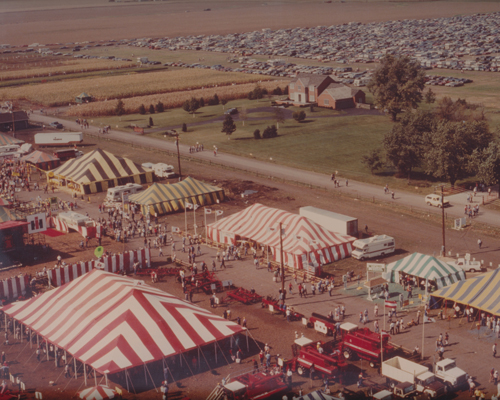
The Farm Progress Show is the oldest and largest outdoor agricultural equipment exhibition in the country. In 1981, it was held at Schachtrup Farms in Brimfield. “It was a year and a half to set up, and over a year to tear it down,” says Mike Schachtrup.
That's when the farm economy was in the deepest trough since the Depression. Interest rates were up to 18 percent. Land values went from $4,200, $4,300 an acre—which was crazy-high at the time—down to $1,700, $1,800. Every day you’d wake up and you'd be worth $10,000 less than the day before. During those years, Steve and I basically worked for nothing. If anything was wrong, you fixed it yourself—you couldn't afford to pay anybody.
So then we had the Progress Show. With Dad’s ability to wheel and deal with all these vendors, it was right up his alley. He'd say, you want to have signs up here on this parcel, you want to have this or that showcased, well here’s what it's going to cost you. [Laughs] We got three years of free seed out of it, and a year and a half’s use of machinery. It was a year and a half to set up, and over a year to tear it down. It was good for the community. The churches made a lot of money; they got all the concession sales.
So who are all of your partners in the farming operations?
Akron Services for marketing and merchandising—we are a licensed state warehouse with them. Cross Implement in Minier; they’re a John Deere dealer. Hensel Seed out of Edelstein for our seed. Kraft Fertilizer out of Princeville. These are all people that you get a history with. It’s a trust thing. My brother and I grew up thinking that if you shake hands, you’ve got a deal. That’s the way we like it. If you have a disagreement, we work it out.
Are you still personally running the combine and tractor on all of your acreage?
Yes, Steve and I. And Greg Smith runs our elevator in Brimfield. We encouraged him to sell crop insurance so we could more vertically integrate, and he's our IT guy. If we've got a problem with the computers in the machinery, he can figure it out.
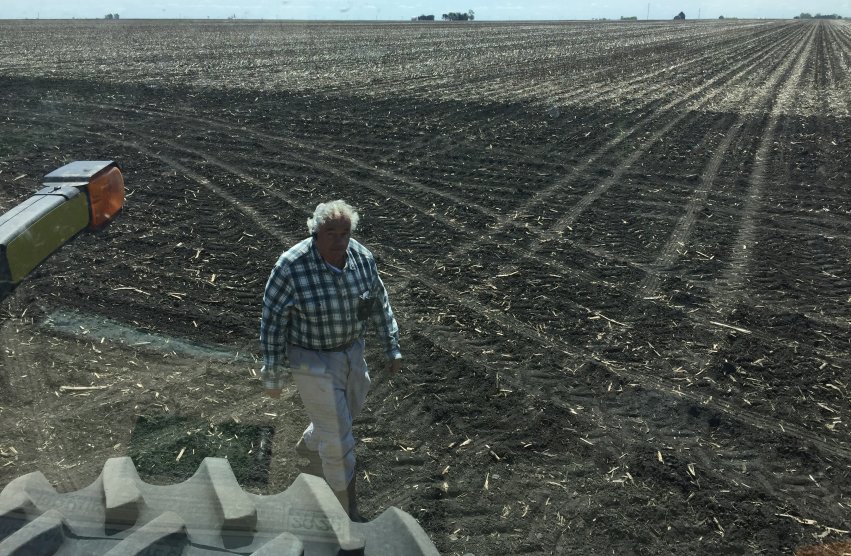
So walk me through the growing season. What happens after planting?
When you get through with planting, you have to clean the equipment up and put it away. Then we've got the sprayer, depending on what type of herbicide, insecticide or fungicide program we may do, depending on the environment and conditions for that growing season. Every season is different.
Post-tassel, you always give it what I call a “suntan lotion,” a fungicide. A corn plant is nothing more than a living organism that converts plant food and water through photosynthesis to a form of usable protein. If the plant has lesions from some disease, you're not going to generate 100 percent of your photosynthetic ability because the leaf surface has been compromised. So you have to have the ability to attack that.
We usually get done spraying in the middle of August, then we've got two or three weeks to get the fall equipment out, get it prepped and hooked up, bins cleaned out, fumigated and ready to start the next program. We start harvest in early September. When we start, we’re in our T-shirts, sweating, knowing that we're not going to be done until the ground's frozen. Spring is a sprint; fall is a marathon.
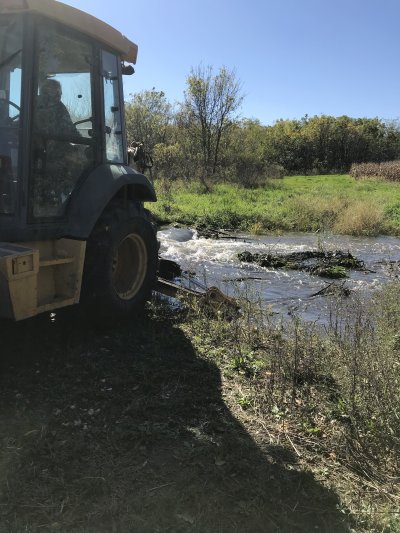 After harvest, we go out with a strip-till machine, which tills a 10-inch wide strip and injects phosphate and potash, but does not disturb the middles between the rows. It’s a conservation measure that leaves the soil undisturbed, helps increase organic matter, and enhances the soil structure and soil flocculation.
After harvest, we go out with a strip-till machine, which tills a 10-inch wide strip and injects phosphate and potash, but does not disturb the middles between the rows. It’s a conservation measure that leaves the soil undisturbed, helps increase organic matter, and enhances the soil structure and soil flocculation.
We put on about a third of our nitrogen in the fall with a nitrogen stabilizer. A lot of guys don't like to do that because it's expensive, but it stabilizes it so it doesn't become active and change from NH3, which is basically ammonia, to NH4, which is corn's favorite form of nitrogen. That means you can put nitrogen on later as a supplement and you know it's not going to run off the soil and contaminate the Gulf [of Mexico]. It's kind of a pain, but it's something we have the ability to do—and to be conscientious stewards of the soil.
Using 360 [Yield Center]’s tools—what's called the Y-DROP—we have the ability to get the nitrogen exactly where we want it. This little rubber hose drags along the crop and dribbles nitrogen right at the base of the plant, on both sides. University of Illinois says it takes 1.2 units of nitrogen to produce a bushel of corn. We're down to about 0.68 to 0.72. Then in the spring, our first trip is to plant. You can count on one thing in central Illinois. Year in, year out, you've got eight days to get the job done right. Between April 20th and May 10th, that's the number of days, on average, that are dry enough. If you don't have dust flying so you can hardly see your planter, then it’s probably too wet. And if you can't plant in eight days, you need bigger equipment or you’ve got too many acres.
Do you generally have your prices locked in prior to planting?
A lot of it, yes. Not through the cash market, but through options, accumulators, things that can be flexible. So if you see a trend coming, you can get out.
So tell me more about these different financial tools: options, accumulators, futures, etc.
In the late ‘80s, Clayton Yeutter said something to me—he ended up being Secretary of Agriculture under George H.W Bush—and it was like somebody turned the light bulb on. He said, if you're going to make it in this business, you have to understand one thing: there's no opportunity in the present in selling your crops. That's why they call it a futures market. By the time you sell your cash crop, I don't care if you think you got a good price, you could have gotten a lot better one—because the merchandisers and the ADMs and Cargills of the world have already wrung the rag out, and you're getting the leftovers. His advice was to learn how to use the futures market, just as you would learn how to use your tractor.
Darren Frye encouraged me to get my commodity broker’s license, which I did. I never did a lot commercially, but it was another arrow in my quiver: a tool you needed to be able to execute and understand futures transactions and feel comfortable with it.
If a young guy came to me and asked about getting into farming, I’d say well, do you know about call options and put options? Do you know about basis contracts? Do you know about hedge to arrive? Do you know about straddles and fences? Do you know how accumulators work? The list goes on and on.
Right now the cash market is so poor, you need some other strategy to pick up a dime here, 15 cents there… otherwise you’re not going to survive. There's no money in $3.50 [per bushel] corn. And then if you store it in the elevator, you have drying and storage costs… By the time they get done nickel-and-diming you, you’re down below the cost of production.
With regard to these complex financial transactions, is that done more in the off-season?
No, that's a daily thing. It depends on when the opportunities arise. Out in the field, in the truck, at home, you're on the phone, always looking for changes in volatility that would create an opportunity.
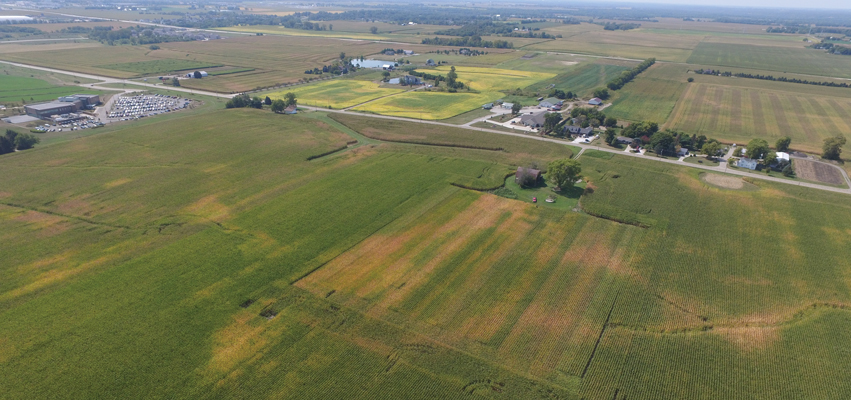
What makes your farm unique?
I don't know if we’re unique, but this area is unique because of our markets and the universities. If you had a map and stick a peg in Peoria, Illinois, and draw a hundred-mile radius, and you stick another peg at Ames, Iowa, and do the same, you're in the Garden of Eden; you’re at the center of the Tigris and Euphrates river valleys. Because of the quality of the land and the climate and geography of the river system. We have some of the best farmland in the world—that's what's unique about it.
And we’ve worked hard to preserve it through conservation. Conservation tillage, conservation waterway management… and you know, it wasn't that way when I was a young guy. The reason these rivers are full of mud is because of past practices over the last 100 years.
But that doesn't happen as much today?
Not as much. You still get it, but people are more cognizant of soil conservation. There are also federal programs that encourage conservation tillage.
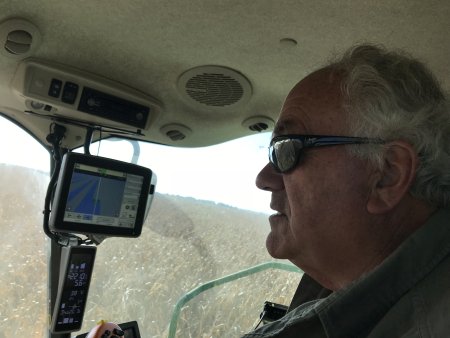 What is the outlook for 2018 in terms of weather or potential yield? Is there any way of knowing?
What is the outlook for 2018 in terms of weather or potential yield? Is there any way of knowing?
Nobody even thinks about it. The only thing you can think about right now is production in South America. If they have a hiccup or production issue, it could impact us as well because we’re in a worldwide market.
What would your dad think about the changes in farming over the years?
He’d love the combines because they’re so space-age, with auto steer and monitors. The planting is a little different because everything is controlled with GPS and monitors… but the harvesting is basically the same, only bigger, faster and better.
Have you seen the monitors and equipment in the cab? It takes a full day to put all that crap in there. And it takes me another day to go out… and see if I can remember how to use it. [Laughs]
The worst days of the year are the first day you plant and the first day you harvest. You’re in and out, you’re up and down… Is this working? Is that working? Is my spacing accurate? Is my depth right? All those things are critical.
Is there anything else you would like to add?
I think my brother and I have been successful because of our work ethic. We are like a yoke of oxen, pulling the plow in the same direction every day. And he's got different talents than I do. He's very talented with machinery; he can fix just about anything. I couldn't have done it without him, and maybe he couldn't have done it without me. My father always said that our biggest asset was each other.
We could not have achieved such success without the hard work and sacrifice from previous generations. We were the generation that was pegged to fritter away the fruits of our predecessors. Conversely, we appreciated our fantastic opportunity, and challenged ourselves to create and maintain a small dynasty in a way of life that challenges you daily. I often smile when I imagine what my great-grandfather, grandfather and father would think if they could see us now. I know my father would say, “You did okay, but could have done better if you had done this instead of that.” This in an occupation that you truly have to be excited about daily to go to work, or the small aggravations and failures would do you in.
There are many wins and many losses, but persistence will prevail in this way of life—and what a life it is. Your main allegiance is to your brain, instinct, past experience and faith in the Almighty that you are the current caretaker of the land, the alpha eagle on the top branch of the tree for only a millisecond in the history of mankind. What a privilege it has been. iBi


